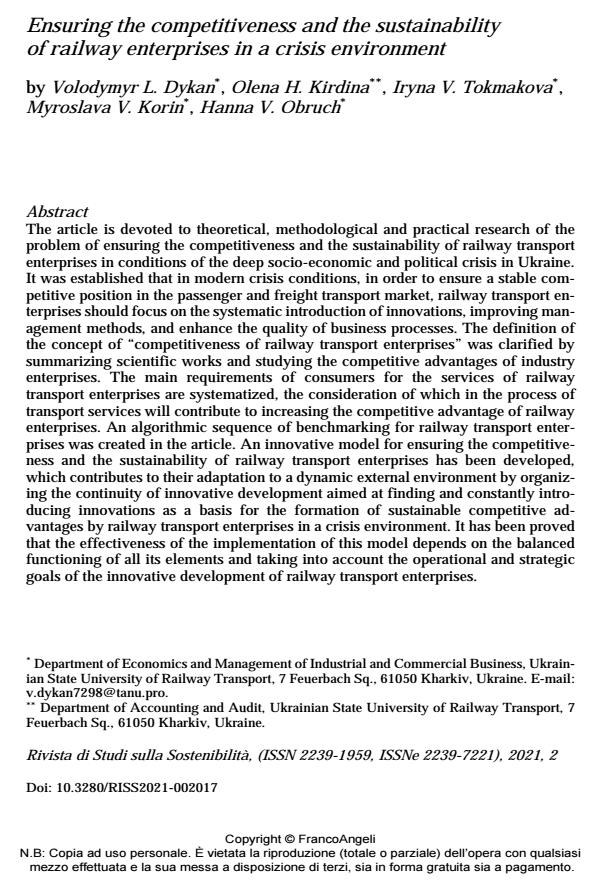Ensuring the competitiveness and the sustainability of railway enterprises in a crisis environment
Journal title RIVISTA DI STUDI SULLA SOSTENIBILITA'
Author/s Volodymyr L. Dykan, Olena H. Kirdina, Iryna V. Tokmakova, Myroslava V. Korin, Hanna V. Obruch
Publishing Year 2022 Issue 2021/2
Language English Pages 13 P. 231-243 File size 585 KB
DOI 10.3280/RISS2021-002017
DOI is like a bar code for intellectual property: to have more infomation
click here
Below, you can see the article first page
If you want to buy this article in PDF format, you can do it, following the instructions to buy download credits

FrancoAngeli is member of Publishers International Linking Association, Inc (PILA), a not-for-profit association which run the CrossRef service enabling links to and from online scholarly content.
The article is devoted to theoretical, methodological and practical research of the problem of ensuring the competitiveness and the sustainability of railway transport enterprises in conditions of the deep socio-economic and political crisis in Ukraine. It was established that in modern crisis conditions, in order to ensure a stable competitive position in the passenger and freight transport market, railway transport enterprises should focus on the systematic introduction of innovations, improving management methods, and enhance the quality of business processes. The definition of the concept of "competitiveness of railway transport enterprises" was clarified by summarizing scientific works and studying the competitive ad-vantages of industry enterprises. The main requirements of consumers for the ser-vices of railway transport enterprises are systematized, the consideration of which in the process of transport services will contribute to increasing the competitive ad-vantage of railway enterprises. An algorithmic sequence of benchmarking for rail-way transport enterprises was created in the article. An innovative model for ensur-ing the competitiveness and the sustainability of railway transport enterprises has been developed, which contributes to their adaptation to a dynamic external envi-ronment by organizing the continuity of innovative development aimed at finding and constantly introducing innovations as a basis for the formation of sustainable competitive advantages by railway transport enterprises in a crisis environment. It has been proved that the effectiveness of the implementation of this model de-pends on the balanced functioning of all its elements and taking into account the operational and strategic goals of the innovative development of railway transport enterprises.
Keywords: transport market, benchmarking, innovation, crisis conditions, compet-itive advantage.
- Smart Technologies in Urban Engineering Oksana Yurchenko, Oleh Strelko, Maryna Rudiuk, Anatoliy Horban, Artemii Bernatskyi, pp.378 (ISBN:978-3-031-46873-5)
- Systems, Decision and Control in Energy VII Oleh Strelko, Oksana Yurchenko, Maryna Rudiuk, Halyna Vasilova, Artemii Bernatskyi, pp.369 (ISBN:978-3-031-90461-5)
Volodymyr L. Dykan, Olena H. Kirdina, Iryna V. Tokmakova, Myroslava V. Korin, Hanna V. Obruch, Ensuring the competitiveness and the sustainability of railway enterprises in a crisis environment in "RIVISTA DI STUDI SULLA SOSTENIBILITA'" 2/2021, pp 231-243, DOI: 10.3280/RISS2021-002017